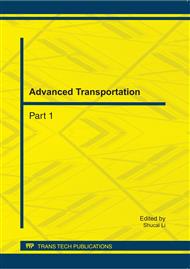p.382
p.386
p.391
p.397
p.402
p.408
p.414
p.418
p.425
Study of Load Spectra of the Jaozhou Bay Expressway Based on MEPDG
Abstract:
To study the traffic characteristic and axles load spectra of Jaozhou bay expressway, WIM data was collected, axle configuration and vehicles classification was determined. The characteristic of truck traffic monthly distribution and the truck hourly distribution was studied and axle load spectra for major tuck class groups were developed. The results show that there were more than 22 truck types running on the expressway, the peaks of truck traffic monthly distribution was in December and the rush hour of the hourly distribution was at noon. All major axles had a bimodal pattern of load spectra.
Info:
Periodical:
Pages:
402-407
Citation:
Online since:
September 2011
Authors:
Keywords:
Price:
Сopyright:
© 2011 Trans Tech Publications Ltd. All Rights Reserved
Share:
Citation:


